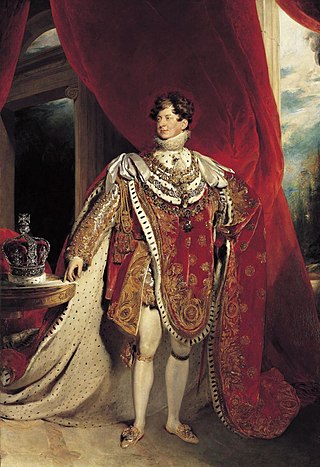
George IV was King of the United Kingdom of Great Britain and Ireland and King of Hanover from 29 January 1820 until his death in 1830. At the time of his accession to the throne, he was acting as prince regent for his father, King George III, having done so since 5 February 1811 during his father's final mental illness.
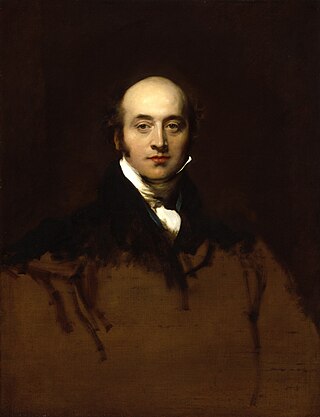
Sir Thomas Lawrence was an English portrait painter and the fourth president of the Royal Academy. A child prodigy, he was born in Bristol and began drawing in Devizes, where his father was an innkeeper at the Bear Hotel in the Market Square. At age ten, having moved to Bath, he was supporting his family with his pastel portraits. At 18, he went to London and soon established his reputation as a portrait painter in oils, receiving his first royal commission, a portrait of Queen Charlotte, in 1789. He stayed at the top of his profession until his death, aged 60, in 1830.
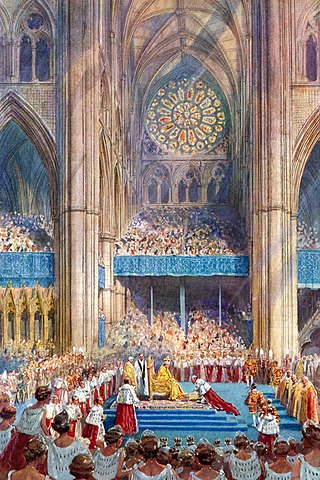
The coronation of the monarch of the United Kingdom is an initiation ceremony in which they are formally invested with regalia and crowned at Westminster Abbey. It corresponds to the coronations that formerly took place in other European monarchies, which have all abandoned coronations in favour of inauguration or enthronement ceremonies. A coronation is a symbolic formality and does not signify the official beginning of the monarch's reign; de jure and de facto their reign commences from the moment of the preceding monarch's death or abdication, maintaining legal continuity of the monarchy.

The Coronation Chair, also known as St Edward's Chair or King Edward's Chair, is an ancient wooden chair on which British monarchs sit when they are invested with regalia and crowned at their coronations. It was commissioned in 1296 by King Edward I to contain the Stone of Scone, which he had captured from the Scots. The chair was named after Edward the Confessor and for centuries it was kept in his shrine at Westminster Abbey.

Sir George Hayter was an English painter, specialising in portraits and large works involving sometimes several hundred individual portraits. Queen Victoria appreciated his merits and appointed Hayter her Principal Painter in Ordinary and also awarded him a Knighthood in 1841.

The Royal Family Order of George IV is an honour that was bestowed as a mark of personal esteem on female members of the British royal family by King George IV. It was the first Royal Family Order issued in the United Kingdom. Prior to George IV's accession in 1820, both ladies and gentlemen of the Court, as well as female members of the royal family, had worn the Sovereign's portrait set in a jewelled frame. George IV formalised the order.

Montagu House was a prominent residence situated near to the southwest corner of Greenwich Park, overlooking the common at Blackheath in what is today southeast London. Adjacent to the Ranger's House, it was the royal residence of Caroline of Brunswick before being demolished in 1815.
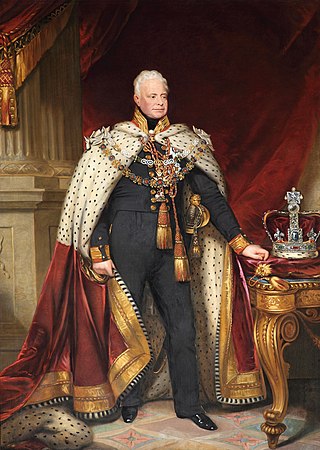
The coronation of William IV and his wife, Adelaide, as King and Queen of the United Kingdom took place on Thursday, 8 September 1831, over fourteen months after he succeeded to the throne of the United Kingdom at the age of 64, the oldest person to assume the throne until Charles III in 2022. The ceremony was held in Westminster Abbey after a public procession through the streets from St James's Palace, to which the King and Queen returned later as part of a second procession.

Conversation Piece at the Royal Lodge, Windsor is an oil-on-canvas painting by Herbert James Gunn. It is part of the collection of the National Portrait Gallery (NPG) in London. The painting depicts King George VI and Queen Elizabeth and their daughters, Princesses Elizabeth and Margaret, taking tea in the Royal Lodge in Windsor Great Park. It was commissioned by the NPG in 1950.

The Trial of Queen Caroline is an 1823 history painting by the British artist George Hayter. It depicts the events of 1820 in which George IV, who had recently succeeded to the throne, attempted to divorce his long-estranged wife Caroline of Brunswick. In order to secure his divorce George had a special bill moved in the House of Lords. The Lords heard evidence of the Queen's adultery, but with public opinion strongly in Caroline's favour, the measure was ultimately withdrawn by the government. Caroline remained married to George until her death the following year.

The Coronation of Queen Victoria is an 1839 painting by the British artist George Hayter. It depicts in oils the Coronation of Queen Victoria at Westminster Abbey on 28 June 1838. Victoria was eighteen when she succeeded her uncle William IV to the throne on 20 June 1837 and went on to reign until 1901.

Caroline, Princess of Wales and Princess Charlotte is an 1801 portrait by the British artist Sir Thomas Lawrence depicting Caroline, Princess of Wales and her daughter Charlotte of Wales, then second in line to the throne after her father George, Prince of Wales who was the eldest son of George III. By this stage in their marriage Caroline and her husband were estranged and effectively separated.

Portrait of Queen Charlotte is a 1789 portrait painting by the English artist Thomas Lawrence of Charlotte of Mecklenburg-Strelitz, Queen Consort of the United Kingdom. Charlotte was the wife of the reigning monarch George III and mother of the future sovereigns George IV and William IV.

Portrait of Charles X is an 1825 portrait painting by the British artist Sir Thomas Lawrence depicting the reigning French monarch Charles X. Following the French Revolution that saw his eldest brother overthrown and executed, Charles has spent many years in exile including a period in Britain. His brother Louis XVIII was restored to the throne with British assistance in 1814 and then again in 1815 following the Battle of Waterloo. Charles, as his heir, led the conservative Ultra-royalist faction in French politics. When his brother died in 1824 he succeeded to the throne. The last member of the House of Bourbon to reign, he had an elaborate coronation in Reims in May 1825. The same year Charles was painted in his coronation robes by the French artist Robert Lefèvre.

The Portrait of Marshal Blücher is an 1814 portrait painting by the English artist Thomas Lawrence of the Prussian Field Marshal Gebhard Leberecht von Blücher.

Portrait of Lord Liverpool is a work by the English artist Thomas Lawrence depicting the British politician and Prime Minister Lord Liverpool.
Sir Hugh Frank John Leggatt was a British art dealer and patron. He was the senior partner in the gallery Leggatt Brothers, and art dealer to members of the Royal Family, including Queen Mary, and Queen Elizabeth, The Queen Mother. Leggatt financed the National Portrait Gallery's commission of the first official portrait of The Princess of Wales.
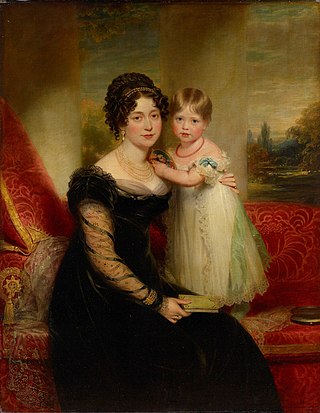
Victoria, Duchess of Kent with Princess Victoria is an 1821 portrait painting by the British artist William Beechey of Victoria, Duchess of Kent and her young daughter the future Queen Victoria. It was painted at Kensington Palace in London and completed the following year. It was exhibited at the Royal Academy in May 1822.
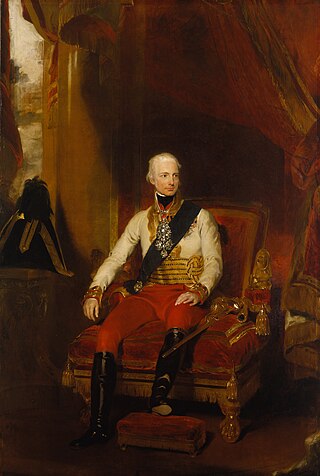
The Portrait of Francis I of Austria is a painting by the British artist Sir Thomas Lawrence depicting the Austrian Emperor Francis I. Commissioned by the Prince Regent of Britain it was initially painted during the Congress of Aix-la-Chapelle in 1818 and completed over the following months. Lawrence, Britain's leading portrait painter of the Regency Era, was commissioned by the Regent to depict many European leaders who had participated in the defeat of the French Empire during the Napoleonic Wars.

George III is am 1809 portrait painting by the English artist Thomas Lawrence depicting the British monarch George III. It depicts the King in his robes for the State Opening of Parliament. It was commissioned by George as a gift for the former Prime Minister of the United Kingdom Henry Addington. George had reigned since 1760, but he was troubled by occasional bouts of mental instability. In 1810, shortly after celebrating the Golden Jubilee on the throne, George was overcome by a more lasting loss of control and his eldest son George was declared Prince Regent. The image by Lawrence continued to be used to represent the King throughout the remainder of his reign.



















